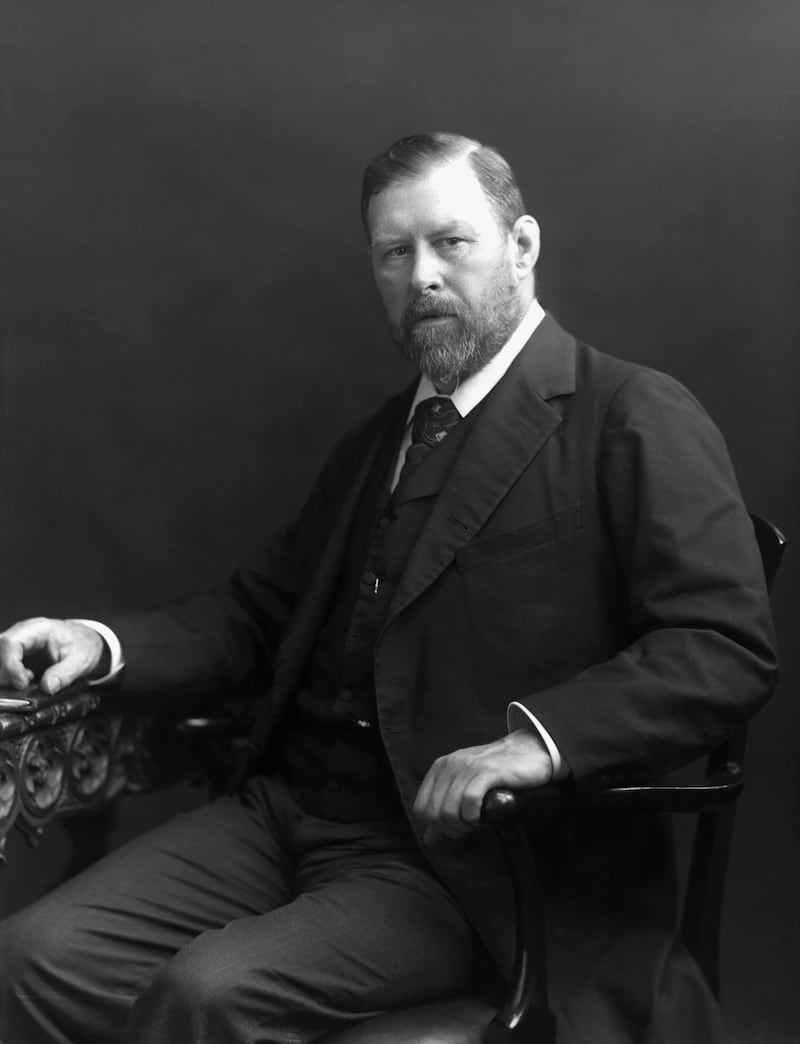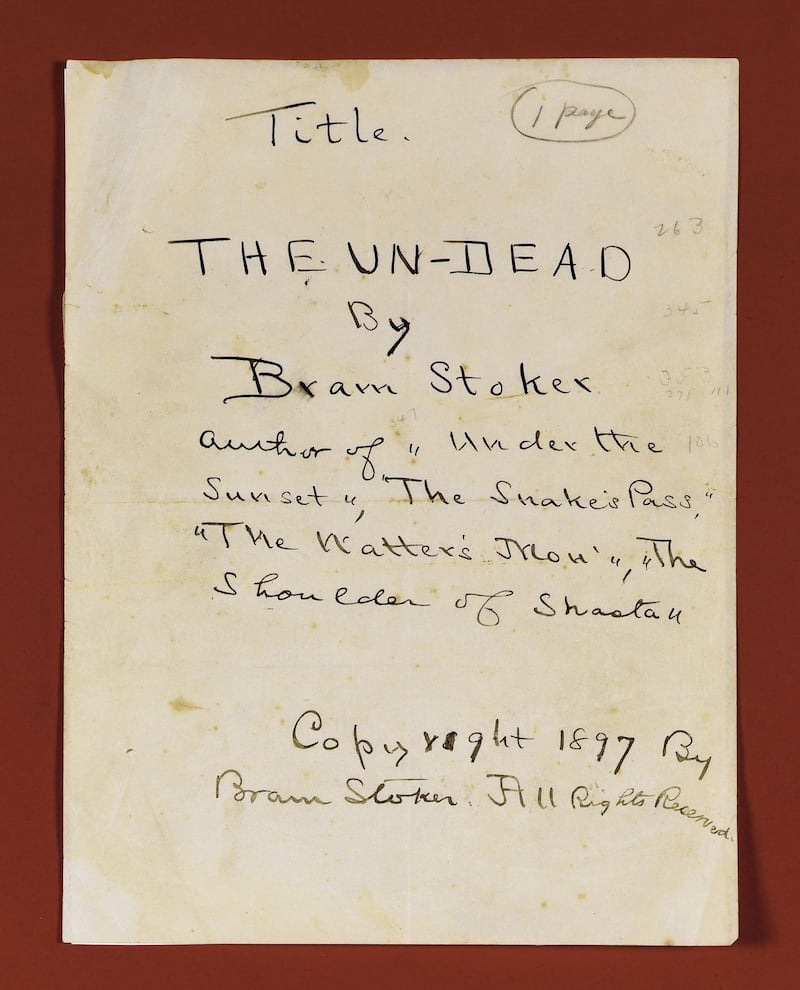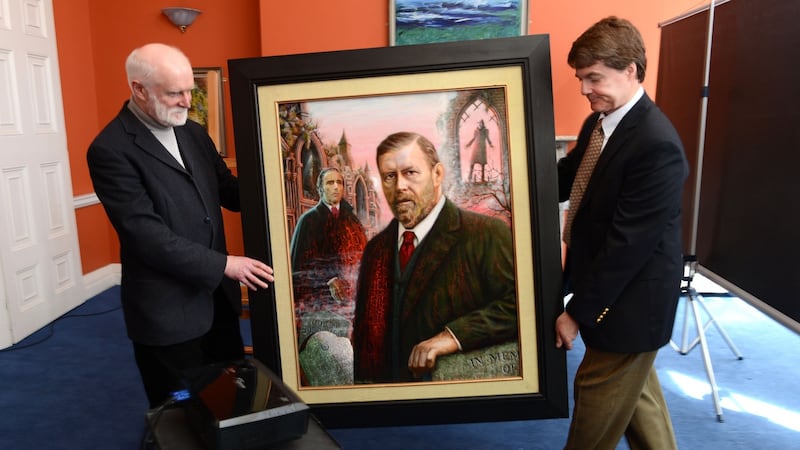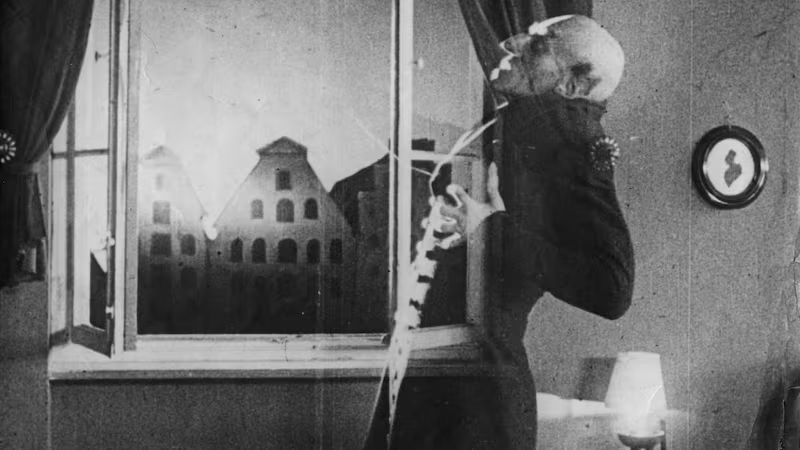“The survivors are like walking skeletons,” observed the English Quaker William Forster. “The town of Westport is a strange and fearful sight, its streets crowded with gaunt wanderers.” In Roscommon, one landlord was described as “worse than Cromwell” by the local priest, as “a Nero or Caligula” by others. In Dublin, on November 8th that year, Abraham “Bram” Stoker was born.
His mother was from Sligo and had written a gruesome memoir about cholera among the local tenants. His father was a civil servant who worked in Dublin Castle. Bram, a lonely child, suffered an illness that made him almost lame, and he rarely attended school. Perhaps his mother read him the supernatural stories of her own rural girlhood: banshees, bad fairies, evil sprites.
His teens saw an astonishing physical transformation as the sickly boy grew into a bear-like athlete who once saved a man from drowning. A mediocre student at Trinity, he became a clerk of petty sessions and an occasional, unpaid theatre critic. Through reviewing, he met the great English actor Henry Irving and moved to London as a young married man to be his assistant at the Lyceum Theatre, which Irving had leased.

It was a risky venture. Theatre was seen by the establishment as disreputable, a nest of prostitutes, low-lifers, disobedient women, dubious men. “Was ever one woman of the theatre more than two steps from harlotry?” asked a contemporary pamphlet condemning the stage as a place of idolatry. When the actor William Terriss was knifed outside London’s Adelphi Theatre in 1897, Irving commented that the killer would never be executed because the victim was only an actor. With Stoker by his side, Irving set out to make theatre respectable. Their relationship was ardent, intensely loving, often turbulent.
Irving was a mesmeric, sexually charismatic figure whose performances of Shakespearean villains were often greeted by terrified screaming. On first meeting the great actor, Stoker himself was thunderstruck by Irving’s recital of The Dream of Eugene Aram, a poem about a bloodcurdling murder. “I sat spellbound,” he would write. “The whole thing was new, re-created by a force of passion which was like a new power.” As the reading concluded, Stoker, generally a mild-mannered sort, “burst out into something like a violent fit of hysterics”.
Injection of zest
The coming years would see many emotional explosions between the two, and life would acquire an even zestier range of colours with the arrival at the Lyceum of the brilliant Ellen Terry, the most famous and highly paid actress of her era. She was funny, unconventional, fiercely smart and independent, and she and Irving became lovers. She was adored by Stoker, too. A trailblazing artist, she would be the only person mentioned by name in Dracula whom Stoker actually knew.
For now, a part-time writer with a highly demanding job, Stoker published criticism, spooky stories and a few rather workaday novels. There is little in his sometimes lifeless early writings to foreshadow the looming masterpiece.

Bram Stoker was far from the first author to pen a vampire story. Long before he wrote Dracula, it must already have seemed that vampires had been done to death. He would have trudged through The Vampyre by John William Polidori (1819), La Morte Amoureuse (The Dead Woman in Love) by Théophile Gautier (1836), James Malcolm Rymer’s Varney the Vampyre (1845-47) and Carmilla (1872) by his countryman Sheridan Le Fanu. From his work with Irving and Terry he would have known the many references to ghosts and vampirism in Shakespeare, from Hamlet’s vow to “drink hot blood” to the statue of slain Julius Caesar spouting gore. But Stoker did something no one had done. He made his vampire someone the reader might pass on Oxford Street.
Far from being, like most early vampire novels, a slab of cod-medievalism, Dracula is a novel of unsettling modernity, featuring telephones, train timetables, women’s magazines, medical innovation, shorthand, audio recording, and, of course, blood transfusion. Stoker’s genius was to migrate the ancient archetype of the bloodsucker into the everyday world of the reader. Prowling by night, sleeping by day, the Count speaks to private anxieties, suppressed sexualities, a subworld of secret selves. This Luciferian noble is more compelling than the innocents he craves, who only come to life when he drains them. In a way, the Count is himself a sort of theatre, in which are staged the neuroses of his era. From Dr Jeckyll and Mr Hyde to The Picture of Dorian Gray, Victorian literature saw stories about a violent, depraved twin. Stoker’s contention was more disturbing, stirring darker recognitions: that we are only one bite from immortality and something in us desires to be bitten.
But intriguingly, Dracula has lighter touches, too. Stoker risks the occasional joke, telling us Dracula “would have made a good lawyer”. The Count is portrayed as raffish good company. In my own novel, Shadowplay, Ellen Terry remarks on the vampire’s charming manners, his fondness for English literature, quoting a passage from Dracula in support.
“Whilst I was looking at the books, the door opened, and the Count entered. He saluted me in a hearty way, and hoped that I had had a good night’s rest. Then he went on.
‘I am glad you found your way in here, for I am sure there is much that will interest you. These companions,’ and he laid his hand on some of the books, ‘have been good friends to me, and for some years past, ever since I had the idea of going to London, have given me many, many hours of pleasure. Through them I have come to know your great England, and to know her is to love her. I long to go through the crowded streets of your mighty London, to be in the midst of the whirl and rush of humanity, to share its life, its change, its death, and all that makes it what it is. But alas! As yet I only know your tongue through books.’ ”
Love of London
Readers should be careful about discerning autobiographical revelation in fiction, but how tempting to imagine that this is Stoker, the London immigrant, allowing himself a moment of appreciative utterance, a nod towards his beloved adoptive city.
For Dracula is a great London novel. Stoker never set foot in Transylvania but London was home all his adult life. What he knew of Dracula’s motherland was gleaned in that remarkable portal to the whole world, the Reading Room of the British Library. But Londoners in Dracula flit frequently to Europe, thinking as little of skedaddling to Amsterdam as they would to Brighton or Whitby, a town Stoker knew well, an important place in Dracula. This is a novel that sees London not so much as well-ordered imperial capital but as metropolitan heart of darkness.

That Dracula is, too, a novel of intense physicality may be one of the reasons for its only limited success on publication. Victorian readers may not have been ready for Stoker’s particular take on the things that go bump in the night. There are scenes that crackle with artfully suppressed eroticism, veiled references to oral sex and premarital coupling, the swapping of blood serving as a metaphor for other intimacies. There are sequences, particularly those involving the notably kickass female vampires, where the book’s sexuality is allowed to boil. Intense same-sex affection is a presence in Dracula; the shimmering eroticism of the novel has led to speculation about Stoker’s orientation. As a young man taken by Leaves of Grass, he began a correspondence with Walt Whitman (they would later meet) in intriguing language.
“I have been more candid with you – have said more about myself to you than I have ever said to any one before. You will not be angry with me if you have read so far. You will not laugh at me for writing this to you. It was with no small effort that I began to write and I feel reluctant to stop, but I must not tire you any more. If you ever would care to have more you can imagine, for you have a great heart, how much pleasure it would be to me to write more to you. How sweet a thing it is for a strong healthy man with a woman’s eyes and a child’s wishes to feel that he can speak so to a man who can be if he wishes father, and brother and wife to his soul. I don’t think you will laugh, Walt Whitman, nor despise me, but at all events I thank you for all the love and sympathy you have given me in common with my kind.”
Wilde relationship
If Whitman was Bram’s lighthouse, another iconic gay writer is so often present in the backstage of Stoker’s life that the two seem silhouettes of each other. Oscar Wilde and Bram were friends at Trinity. Stoker’s wife, Florence Balcombe, a peerless Dublin beauty, had been engaged to Wilde at one point. Their parting gift, piquantly for Dracula fans, was a crucifix.
But not all of Dracula’s influences were people Stoker knew. Those who have lived in cities beset by terrorism can have some idea of what London felt like during the Ripper murders. Fears cawed like rooks. The predator seemed to rove at will. Vile graffiti splashed on walls blamed “the jewes”. The miasma of dread that gripped the fog-darkened capital loomed at Stoker, too. The ripper walks the margins of Dracula in spirit, before the attacker is destroyed by being stabbed with a stake, as one of the Ripper’s victims was.

Some have seen Irving as the model for Dracula but there is no hard evidence. Indeed, in his shatteringly long biography of Irving, a snowstorm of facts unmitigated by insights, Stoker doesn’t mention Dracula at all. As a novelist myself, I wonder if novelists have role models in that sense. Novelists don’t draw what they see; they imagine the pictures. A kind of osmosis goes on as a novel is being shaped, but it’s something more complex than mimicry. Writing is about being haunted.
And Dracula is a novel about writing. Its narrative technique is epistolary, a strategy that supercharges the storytelling. Stoker makes voyeurs of us, as we read other people’s letters. The novel’s many jottings and telegraphed words lend an exhilarating breathlessness to the prose. Dracula, a powerful antidote to the multivolume Victorian door-stopper, knows the reader has other things to do. Stoker’s experiences in the theatre have brought his work a powerful sense of the dramatic. He paints his chiaroscuro deftly and is not afraid to deploy smoke and mirrors. Once he gets you into your seat, he locks the doors.
That this scalding tale of eternal love was written by a quiet clerk from Dublin is not its strangest element. That honour belongs to Dracula’s afterlife. Stoker died in 1912, not desperately poor but by no means financially comfortable, having lost his income on Irving’s death in 1905. Some years after Stoker’s passing, a German film company produced the pirated film, Nosferatu. Florence Balcombe, Stoker’s redoubtable widow, sued and won. But the movies fell for the Count, who has refused to stay dead ever since. Filmed dozens of times, selling tens of millions of copies, in hundreds of languages, inspiring scores of imitators, Dracula has become the most successful supernatural novel in history.
I look at a photograph of Stoker’s inscrutable face and wonder what on earth he would make of it all. This Halloween, I’ll picture him laughing.
Joseph O’Connor’s novel Shadowplay is published by Harvill Secker. He will be in conversation with Liz Nugent at the Pavilion Theatre, Dún Laoghaire, on October 30th. Booking at paviliontheatre.ie or 01-2312929. This essay is an abridged version of his introduction to the new Vintage Classic edition of Bram Stoker’s Dracula. The Bram Stoker Festival runs until October 28th



















